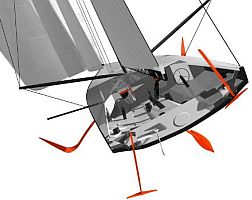
Volvo Ocean Concept Design
Almost two years ago, we raised the question — Are the new foiling Open 60 monohulls “the future of ocean racing or [are they] a foil too far?” The results of the Vendee Globe around-the-world, single-handed race last January may have answered that question. Armel Le Cléac’h crossed the finish line in France on January 19, 2017, winning in record time, sailing the foil-assisted IMOCA 60 Banque Populaire VIII. The next three finishers were also foil-assisted boats. The success of foiling monohulls in what is arguably the world’s toughest race may have changed the face of international racing.
The foil-assisted boats feature curved hydrofoil daggerboards which provide lift and help counteract heel. They are beautifully engineered carbon-fiber creations. Many of the early attempts failed as the designers worked to get the scantlings just right. In the 2015 Transat Jacques Vabre from Le Havre, France, to Itajaí, Brazil, for example, five of the foil-assisted designs started the 20-boat race, but only one finished.
After the success of the foilers in the 2016-2017 Vendee Globe, it appears that many of the engineering challenges have been solved. Of the 29 boats starting the race, 18 finished. 7 of the racers were foilers, of which 5 finished. Overall, the foiler-assisted boats broke down at a rate no higher than the conventional IMOCA 60s without foils and perhaps, most notably, foilers won the top four slots.
The world of international sailing took notice. In May, the Volvo Ocean Race committee announced that their 2019-20 race would be sailed in 60′ foil-assisted monohulls.
Then, in September, in a dramatic departure from the last two rounds of America’s Cup races, the winners of the cup, Team New Zealand, announced that the 36th America’s Cup in Auckland will be also be sailed in foiling monohulls instead of catamarans. Team New Zealand, noting that a team of designers are working on monohull concepts after having consulted with a number of potential challengers.
“There is an overall desire to have a spectacular monohull yacht that will be exciting to match race, but also one that the public and sailors can relate to as a sail boat that really challenges a full crew of professional yachtsman around the race track,” Team New Zealand said in a statement.
A short video about foiling monohulls:

From general remarks by skippers of the most recent Globe race, it seems as though the limitation on performance of these boats may come down to how much pounding and noise the human frame can take, especially when it comes to getting rest. Not really a factor for the America’s Cup, but for extended races this factor may narrow the field of able crew members.
Interesting point, Doug. I read that the noise level on the carbon fiber sleds at speed could do permanent ear damage and that noise reducing earphones were being considered. Of all possible races, the non-stop singlehanded Vendee Globe has got to be the worst race to sail the carbon mono foilers.